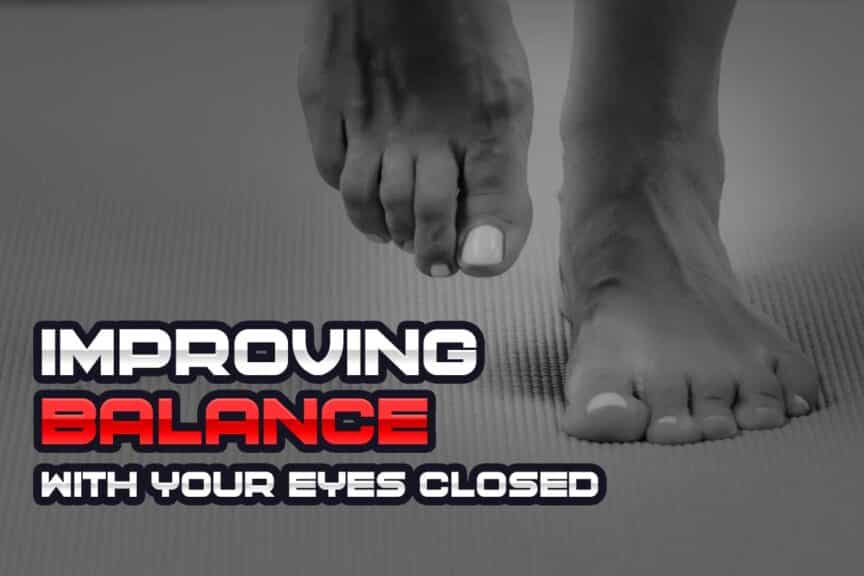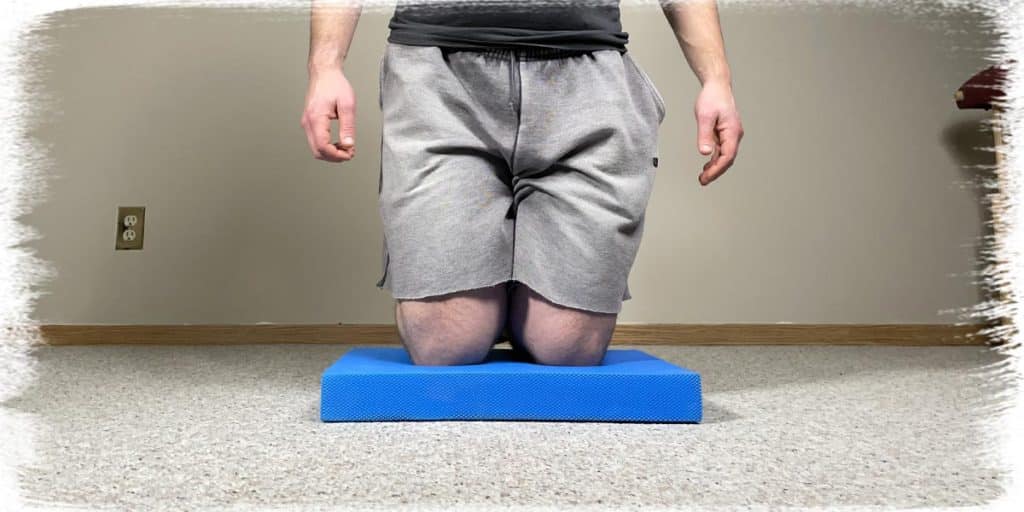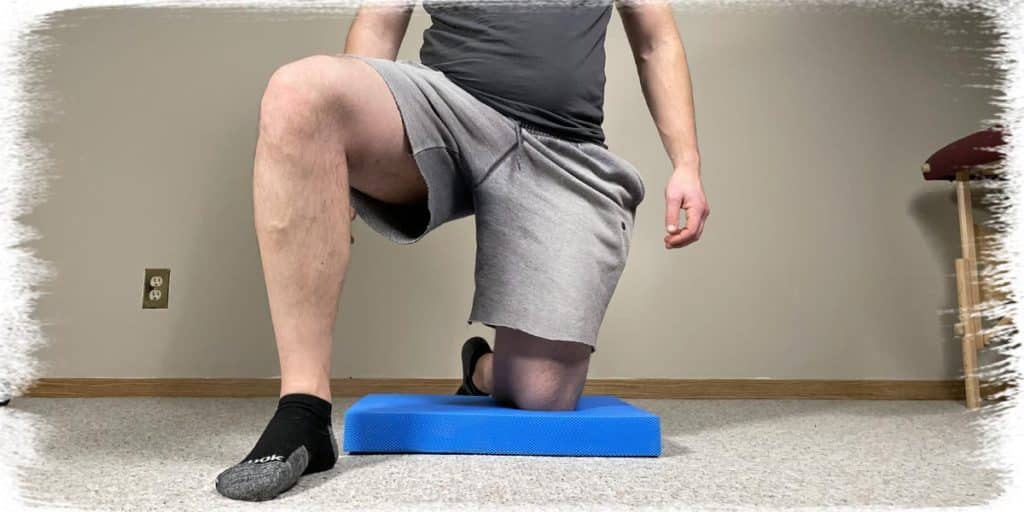Improving your ability to balance your body with your eyes closed can yield some potent benefits when it comes to preventing falls, improving confidence, and enhancing one’s overall quality of life. If you are looking to learn how you can begin to improve your balance without using your vision, this article will walk you through what you need to know!
Improving your balance when your eyes are closed is best done with the appropriate progression of exercises that challenges your balance while keeping you safe. Such exercises include:
- Seated exercises (and progressions)
- Walking backwards (and progressions)
- Challenging static AND dynamic balance
Those are, of course, a very simplistic overview of how to improve your eyes-closed balance, and if you want the full breakdown on each one of these categories, be sure to keep on reading!
ARTICLE OVERVIEW (Quick Links)
Click/tap on any of the headlines below to instantly read that section!
• Why it’s harder to balance with eyes closed
• The appropriate progressions to use (safety)
• Seated exercises (and progressions)
• Kneeling exercises (and progressions)
• Walking backwards (and progressions)
Related article: How Can Physical Therapy Help with Balance Issues?
Disclaimer: While I am a physical therapist, I am not YOUR physical therapist. As a result, I cannot tell you whether or not any treatments mentioned on this website may or may not be appropriate for you, including balance exercises. By following any information within this post, you are doing so at your own risk. You are advised to seek appropriate medical advice for any balance issues you may be experiencing.
Why it’s harder to balance with eyes closed
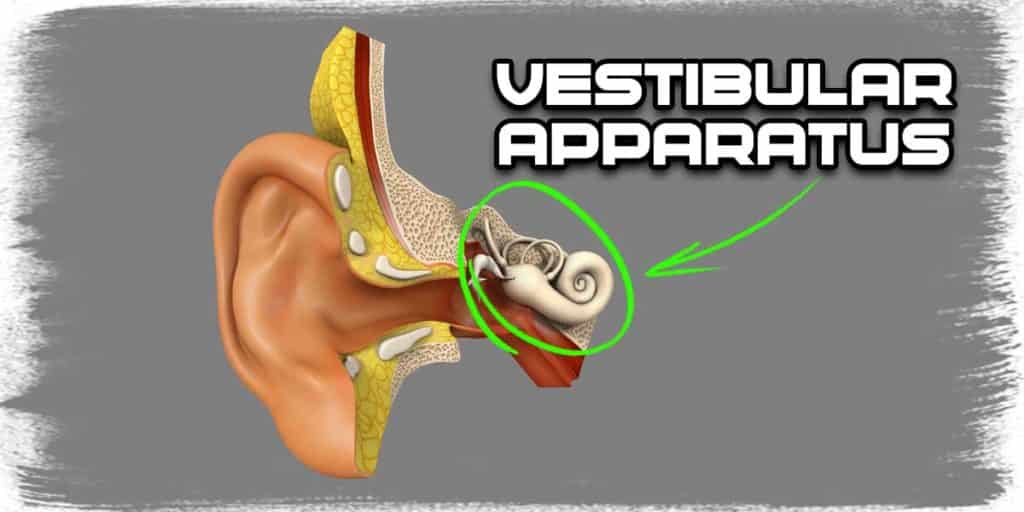
Your body acquires its ability to achieve (and maintain) standing, upright balance through four means, comprised from three distinct systems:
- The vestibular system
- The visual system
- Proprioception (a component of the somatosensory system)
- Physical strength (a component of the somatosensory system)
Each of these inherent systems in the body works together to ensure you can maintain your balance.2 While I won’t be covering the specifics of these systems within this article, here’s what you need to know:
If any one of these three systems is impaired in any sort of manner, your brain and body must rely on any of the two remaining systems to a greater extent to provide the appropriate information to the brain for maintaining balance.
So, when we close our eyes, the visual information that our brain relies on receiving to help provide the necessary information to maintain balance is eliminated. And, as it turns out, our brain receives A LOT of information from our visual system when it comes to interpreting our positional awareness.
The appropriate progressions to use (safety)
Whenever we attempt to get better at anything (a skill, knowledge or physical ability, etc.), progressing the challenge in an appropriate manner is the cornerstone to success. The correct amount of challenge affords us equal successes and mistakes, which serve to both motivate us and optimize the learning process overall.1
When it comes to improving balance, there’s always the risk of falling. As such, safety is always priority number one when challenging your balancing abilities. You should always feel safe whenever working on your balance. If you don’t feel safe, regressing the movement to the point that challenges you while continuing to feel safe must be done; it is a non-negotiable.
It may also be wise to have a friend, family member, or other individual remain by your side to help ensure you keep your balance.
A typical eyes-closed progression to follow:
- Seated position without movement (static balance)
- Seated position with small, inner range movements
- Seated position with large, dynamic movements
- Tall-kneeling or half-kneeling without movement
- Tall-kneeling or half-kneeling with small movements
- Tall-kneeling or half-kneeling with large, dynamic movements
- Standing position without movement
- Standing position with small, inner range movements
- Standing position with large dynamic movements
Universal ways to challenge balance for any position:
- Decrease the base of support by narrowing your stance-width
- Decrease the base of support by lifting one foot off the ground
- Slow the movement down or lengthen the time required to balance
- Perform larger movements
Seated exercises (and progressions)
The following are some balance exercises that you can try from a seated position. This is the safest way to start out if you have never performed balancing exercises with your eyes closed. You can also try combinations of the following exercises based on your balancing abilities.
Related article: How to Strengthen Your Ankles While Sitting Down (Easy to do)
Feet together
This is the starting point for anyone with poor balance who is attempting to balance with their eyes closed for the first time. You might not need to practice this one very much, but start here, just to be safe.
While seated in your chair, simply bring both of your feet together and then close your eyes. If you can maintain this position for at least thirty seconds, you’re probably good to try a more advanced challenge.
One foot off the ground
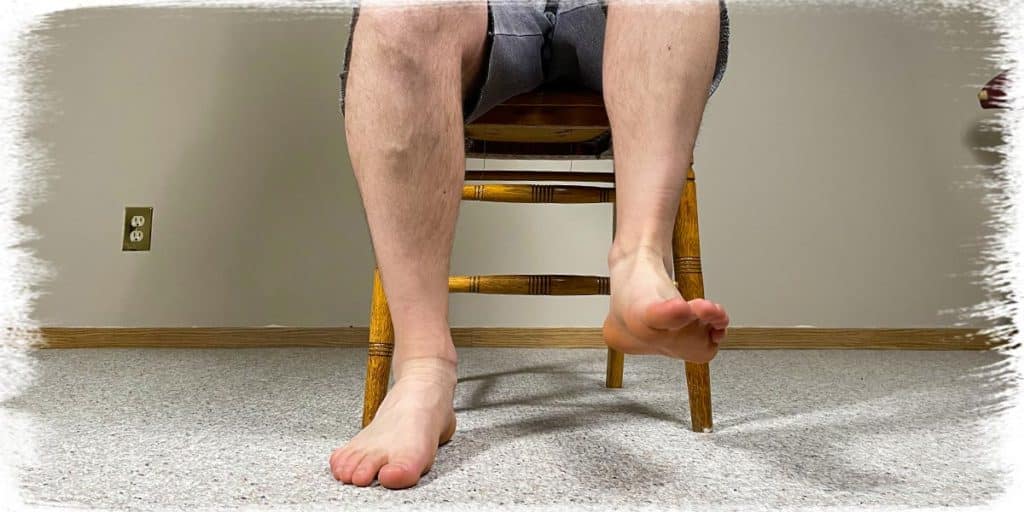
If having both your feet on the ground is too easy, lift one foot off the ground and try to maintain your balance again. Just lift the foot off the ground by an inch or two in case you need to quickly set it down to re-gain your balance.
Make sure to try this with each foot. If you can hold for at least thirty seconds on each side, you’re likely safe to try something more challenging.
Left & right head rotations
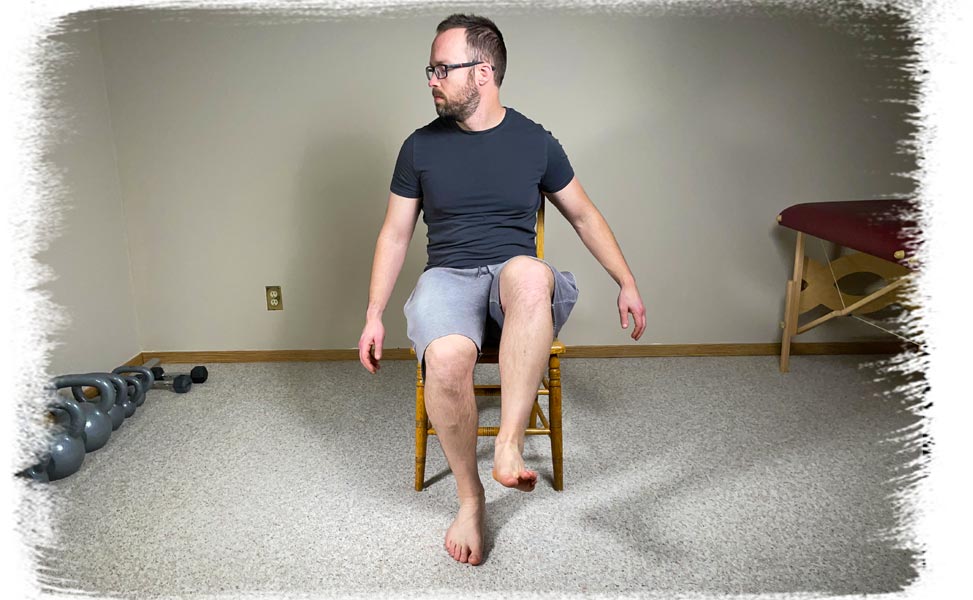
Turning your head left and right while keeping your eyes closed is now going to start challenging a bit more of your dynamic balance (I.e. maintaining balance while producing movement). It will also stimulate your vestibular system since your head is moving.
Start with both feet flat on the floor and slowly rotate your head from side to side at a comfortable speed. If you can do this for thirty seconds, try lifting one foot off the ground and repeating. If you can do this with each foot, you can consider progressing to something more difficult.
Kneeling exercises (and progressions)
Kneeling exercises are the perfect intermediate challenge between sitting and standing exercises; they are more challenging than seated but are much safer than standing exercises since you’re still rather close to the ground.
You can really optimize the challenge with these progressions based on how wide or narrow you make your base of support, especially when in the half-kneeling position.
Pro tip: It helps to do these progressions right by a stable surface of some kind (a desk, bed, chair, etc.) that you can quickly reach out and grab for support if you feel that you’re starting to lose your balance.
Narrow base of support
Whether you use a half-kneeling position or a tall-kneeling position, the width of your legs can extensively influence the balance requirements you’ll need.
The more narrow your base of support becomes, the more challenging it will be for your balance.
Start by finding an appropriate base of support and closing your eyes. If you can get thirty seconds, try with a more narrow base. If you’ve gone as narrow as possible, try the next progression.
Head rotations

Just like you did with your seated head rotations, try incorporating this movement now into your kneeling positions. Rotate your head left and right in a controlled and pain-free manner as quickly as comfortable.
Start with very small rotations and then scale up from there as you gain confidence/ability with your balance.
Upper body rotations

Once you’re confident with rotating your head, you can increase the challenge by rotating your entire upper body.
It may be worth keeping your eyes open for the first handful of attempts until you feel like you’re ready to close your eyes when performing the movement.
Walking backwards (and progressions)
Walking backwards (while keeping your eyes open) can be an effective way to improve your balance with your eyes closed. It can also be a great way to improve your balance if you’re hesitant about closing your eyes.
Backwards walking is excellent since it eliminates much of the visual information that your brain is used to relying on while walking, yet doesn’t eliminate visual input entirely (you can’t see where you’re going but still get some information about your surroundings).
The caveat is that you need to make sure that you have plenty of open space behind you, as you want to have peace of mind knowing you won’t trip over anything, step on any uneven terrain, etc.
Start by going as slowly as possible, making sure that you feel confident in your ability to remain upright.
Pro tip: A long hallway works great for this, as you have a long walkway and can place your arm up against the wall for stability (should you need it) at any time.
General recommendations:
- Start with shorter distances and increase them as your confidence improves
- Start at a generally slower pace and increase your speed as your confidence increases
- If you really want to up the challenge, walk with a narrow base of support (as if walking on an imaginary tightrope).
Final thoughts
Having adequate balance is a critically important ability to ensure high quality of life, safety, and even physical performance. Working on your balance while removing any visual information (I.e. closing your eyes) that your brain uses to maintain balance will force the other balance-related systems in your body to adapt and improve in response to no visual input.
As always, make sure that these exercises and progressions are appropriate for you and that you feel safe while performing them. Practice them regularly (at least 1-2 times per day), and hopefully, you’ll notice an improvement within a few weeks’ time!
References:
- Ma Q, Pei G, Meng L. Inverted U-shaped curvilinear relationship between challenge and one’s intrinsic motivation: Evidence from event-related potentials. Frontiers in Neuroscience. 2017;11. doi:10.3389/fnins.2017.00131
- Winter DA. Human balance and posture control during standing and walking. Gait & Posture. 1995;3(4):193-214. doi:10.1016/0966-6362(96)82849-9

Hi! I’m Jim Wittstrom, PT, DPT, CSCS, Pn1.
I am a physical therapist who is passionate about all things pertaining to strength & conditioning, human movement, injury prevention and rehabilitation. I created StrengthResurgence.com in order to help others become stronger and healthier. I also love helping aspiring students and therapists fulfill their dreams of becoming successful in school and within their clinical PT practice. Thanks for checking out my site!

